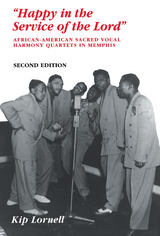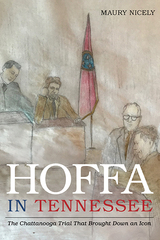4 start with H start with H

The author traces the evolution of such groups as the I. C. Glee Club Quartet, the Spirit of Memphis, the Sunset Travelers, and the Southern Wonders from the early 1920s to the late 1980s. Drawing on extensive interviews and field research, Lornell describes a unique world of radio personalities, quartet unions, fans, promoters, and singing teachers. What emerges is a fascinating picture of the complex, multilayered relationships within these communities, enhanced by a probing analysis of the gospel quartets' place within the larger contexts of popular culture and African-American history.
"Happy in the Service of the Lord" was first published in 1988. For this second edition, Lornell has added a new chapter on the role of gospel composers and the importance of spirituality in quartet performances. The first chapter, a survey of the history of quartet singing across the United States from Reconstruction to the present, has been completely rewritten to reflect the most recent scholarship. Lornell has also updated and expanded the book's audiography and bibliography.

First named the Highlander Folk School and established in 1932 by Myles Horton and Don West near Monteagle, Tennessee, this adult education center has been both a vital resource for southern and Appalachian activists and a catalyst for several major movements for social change. During its first thirty years, Highlander served as a community folk school, as a training center for southern labor and Farmer's Union members, and as a meeting place for black and white civil rights workers. Its advocacy of racial equality ultimately prompted the state of Tennessee to revoke the charter of the original institution in 1962. Undaunted, the school's officers reorganized the institution as the Highlander Research and Education Center in Knoxville, where it gave ongoing support to the civil rights movement and promoted a multiracial poor people's coalition. Today, operating in New Market, Tennessee, it continues to devise new strategies of progressive change from the experiences of ordinary people.
This comprehensive history offers a unique perspective on the movements, institutions, organizations, and individuals that permanently reshaped our understanding of the South and Appalachia in the twentieth century. It also suggests the range of problems and possibilities of using education to achieve economic, political, and racial justice.

The harmonies of the Fisk Jubilee Singers, the measured brush strokes of painter Lloyd Branson, the intricate basket weaving of Maggie Murphy, the influence of the Agrarian literary movement, and the theater barnstorming of actor-manager Sol Smith—such are the sounds, images, and expressions of Tennessee’s arts legacy.
Through its interlocking themes of tradition and innovation, A History of Tennessee Arts: Creating Traditions, Expanding Horizons traces the story of the arts in Tennessee from its formal, more academic side to its vernacular expressions of culture, self, and community. Both the formal and the vernacular contribute to an understanding of what the arts mean to Tennesseans and, in turn, what Tennesseans have to offer the culture of the state, the region, and the nation. A history of the arts in the Volunteer State becomes, then, an evolving barometer of not only where we have been as a culture, but also how we have matured as a society.
This richly illustrated book, cosponsored by the Tennessee Arts Commission and the Tennessee Historical Society, covers the varieties of art in Tennessee in five parts. The visual arts and architecture section includes chapters on vernacular and high style architecture, sculpture, painting and photography, while the section on craft arts celebrates folk arts such as woodcraft, silversmithing, pottery, and textiles. The section on Tennessee’s rich literary history includes such writers as James Agee, Robert Penn Warren, and Evelyn Scott, while the performing arts are represented by a wealth of storytellers along with two centuries of stage history. Finally, Tennessee is home to—and originator of—much of the music that we know as distinctively American. Contributors to the music section examine gospel, blues, rock, soul, and, of course, country music.
From prehistoric cave paintings to the “cow punk” of Jason and the Scorchers, from the elegant capitol building of William Strickland to Ballet Memphis, and from the unique cantilevered barns of East Tennessee to the chronicles of Alex Haley, the arts in Tennessee truly celebrate traditions and strive to expand our horizons.
The Editor: Carroll Van West is director of the Center for Historic Preservation at Middle Tennessee State University and senior editor of the Tennessee Historical Quarterly.

By the early 1960s, Jimmy Hoffa had a stranglehold on the presidency of the Teamsters Union. However, his nemesis, Attorney General Robert F. Kennedy, was convinced that Hoffa was a corrupt force whose heavy-handed influence over the union threatened the nation. As Attorney General, Kennedy established a “Get Hoffa Squad” that set out to unearth criminal wrongdoing by the labor leader in order to remove him from power. A number of criminal trials in the 1950s and early 1960s resulted in not-guilty verdicts for Hoffa. Matters would finally come to head in Chattanooga, Tennessee, in a climatic, but often overlooked, historical moment chronicled by Maury Nicely in this engrossing book.
After a Christmastime 1962 acquittal in Nashville of charges that Hoffa had illegally received funds from a trucking company in exchange for settling a costly strike, it was discovered that several attempts had been made to bribe jurors. Fresh charges of jury tampering in that case were quickly filed against Hoffa and five others. Moved to Chattanooga, the new trial was held before a young, relatively untested federal judge named Frank Wilson. The six-week courtroom conflict would devolve into a virtual slugfest in which the defense team felt was necessary to turn its ire against Wilson, hoping to provoke an error and cause a mistrial. As Nicely shows in vivid detail, Hoffa’s Chattanooga trial became the story of a lone, embattled judge struggling mightily to control a legal proceeding that teetered on the edge of bedlam, threatening to spin out of control. In the end, Hoffa was convicted-an extraordinary change of fortune that presaged his downfall and mysterious disappearance a decade later.
In examining how justice prevailed in the face of a battering assault on the judicial system, Hoffa in Tennessee demonstrates how a Chattanooga courtroom became a crucial tipping point in Jimmy Hoffa’s career, the beginning of the end for a man long perceived as indomitable.
READERS
Browse our collection.
PUBLISHERS
See BiblioVault's publisher services.
STUDENT SERVICES
Files for college accessibility offices.
UChicago Accessibility Resources
home | accessibility | search | about | contact us
BiblioVault ® 2001 - 2024
The University of Chicago Press









